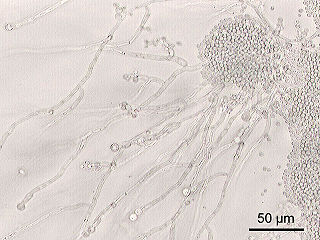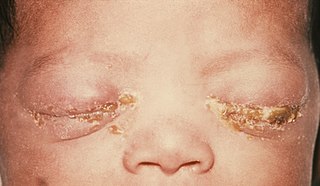 W
WChlamydia, or more specifically a chlamydia infection, is a sexually transmitted infection caused by the bacterium Chlamydia trachomatis. Most people who are infected have no symptoms. When symptoms do appear they may occur only several weeks after infection; the incubation period between exposure and being able to infect others is thought to be on the order of two to six weeks. Symptoms in women may include vaginal discharge or burning with urination. Symptoms in men may include discharge from the penis, burning with urination, or pain and swelling of one or both testicles. The infection can spread to the upper genital tract in women, causing pelvic inflammatory disease, which may result in future infertility or ectopic pregnancy.
 W
WBalanitis circinata is a skin condition of reactive arthritis comprising a serpiginous ring-shaped dermatitis of the glans penis. Circinate balanitis is one of the most common cutaneous manifestation of reactive arthritis. However, balanitis circinata can also occur independently. Topical corticosteroid therapy is the most commonly used treatment, and topical calcineurin inhibitors have also been used successfully.
 W
WChlamydia abortus is a species in Chlamydiae that causes abortion and fetal death in mammals, including humans. Chlamydia abortus was renamed in 1999 as Chlamydophila psittaci along with all Chlamydiae except Chlamydia trachomatis. This was based on a lack of evident glycogen production and on resistance to the antibiotic sulfadiazine. In 1999 C. psittaci and C. abortus were recognized as distinct species based on differences of pathogenicity and DNA–DNA hybridization. In 2015, this new name was reverted to Chlamydia.
 W
WThis is the list of healthy vaginal microbiota (VMB), which is defined as the group of species and genera that generally are found to have lack of symptoms, absence of various infections, and result in good pregnancy outcomes. VMB is dominated mainly by Lactobacillus species. This is the list of organisms that are found in the lower reproductive tract of sexually mature women who are not immunocompromised. A partial description of pathogens that can be found in the lower and upper reproductive tract of women can be found in the article sexually transmitted disease. The organisms listed below are capable of causing illness if for some reason there is a change in vaginal pH or a change in the ratio of one organism to another. For example, Candida is a normal inhabitant of a healthy reproductive tract but an overgrowth of this organism can cause candidiasis.
 W
WLymphogranuloma venereum is a sexually transmitted disease caused by the invasive serovars L1, L2, L2a, L2b, or L3 of Chlamydia trachomatis.
 W
WNeonatal conjunctivitis is a form of conjunctivitis which affects newborn babies following birth. It is typically due to neonatal bacterial infection, although can also be non-infectious. Infectious neonatal conjunctivitis is typically contracted during vaginal delivery from exposure to bacteria from the birth canal, most commonly Neisseria gonorrhoeae or Chlamydia trachomatis.
 W
WPelvic inflammatory disease, also known as pelvic inflammatory disorder (PID), is an infection of the upper part of the female reproductive system, namely the uterus, fallopian tubes, and ovaries, and inside of the pelvis. Often, there may be no symptoms. Signs and symptoms, when present, may include lower abdominal pain, vaginal discharge, fever, burning with urination, pain with sex, bleeding after sex, or irregular menstruation. Untreated PID can result in long-term complications including infertility, ectopic pregnancy, chronic pelvic pain, and cancer.
 W
WTrachoma is an infectious disease caused by bacterium Chlamydia trachomatis. The infection causes a roughening of the inner surface of the eyelids. This roughening can lead to pain in the eyes, breakdown of the outer surface or cornea of the eyes, and eventual blindness. Untreated, repeated trachoma infections can result in a form of permanent blindness when the eyelids turn inward.
 W
WTubo-ovarian abscesses are one of the late complications of pelvic inflammatory disease (PID) and can be life-threatening if the abscess ruptures and results in sepsis. It consists of an encapsulated or confined 'pocket of pus' with defined boundaries that forms during an infection of a fallopian tube and ovary. These abscesses are found most commonly in reproductive age women and typically result from upper genital tract infection. It is an inflammatory mass involving the fallopian tube, ovary and, occasionally, other adjacent pelvic organs. A TOA can also develop as a complication of a hysterectomy.